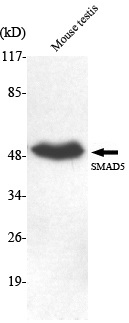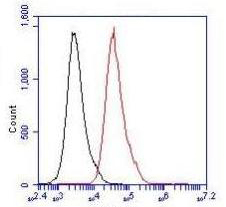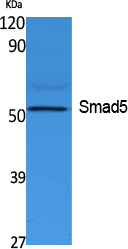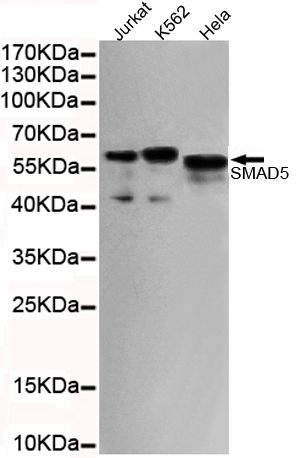Smad5 Monoclonal Antibody
- Catalog No.:YM1093
- Applications:WB;IF;FCM
- Reactivity:Human;Mouse;Rat;Bovine;Chicken;Pig;sheep
- Target:
- Smad5
- Fields:
- >>TGF-beta signaling pathway;>>Signaling pathways regulating pluripotency of stem cells
- Gene Name:
- SMAD5
- Protein Name:
- Mothers against decapentaplegic homolog 5
- Human Gene Id:
- 4090
- Human Swiss Prot No:
- Q99717
- Mouse Gene Id:
- 17129
- Mouse Swiss Prot No:
- P97454
- Rat Gene Id:
- 59328
- Rat Swiss Prot No:
- Q9R1V3
- Immunogen:
- Purified recombinant human Smad5 (C-terminus) protein fragments expressed in E.coli.
- Specificity:
- Smad5 Monoclonal Antibody detects endogenous levels of Smad5 protein.
- Formulation:
- Liquid in PBS containing 50% glycerol, 0.5% BSA and 0.02% sodium azide.
- Source:
- Monoclonal, Mouse
- Dilution:
- WB 1:1000 - 1:2000. IF 1:100 - 1:500. Flow cytometry: 1:100 - 1:200. Not yet tested in other applications.
- Purification:
- Affinity purification
- Concentration:
- 1 mg/ml
- Storage Stability:
- -15°C to -25°C/1 year(Do not lower than -25°C)
- Other Name:
- SMAD5;MADH5;Mothers against decapentaplegic homolog 5;MAD homolog 5;Mothers against DPP homolog 5;JV5-1;SMAD family member 5;SMAD 5;Smad5;hSmad5
- Molecular Weight(Da):
- 52kD
- Background:
- The protein encoded by this gene is involved in the transforming growth factor beta signaling pathway that results in an inhibition of the proliferation of hematopoietic progenitor cells. The encoded protein is activated by bone morphogenetic proteins type 1 receptor kinase, and may be involved in cancer. Alternative splicing results in multiple transcript variants. [provided by RefSeq, Feb 2014],
- Function:
- function:Transcriptional modulator activated by BMP (bone morphogenetic proteins) type 1 receptor kinase. SMAD5 is a receptor-regulated SMAD (R-SMAD).,PTM:Phosphorylated on serine by BMP (bone morphogenetic proteins) type 1 receptor kinase.,PTM:Ubiquitin-mediated proteolysis by SMAD-specific E3 ubiquitin ligase SMURF1.,similarity:Belongs to the dwarfin/SMAD family.,similarity:Contains 1 MH1 (MAD homology 1) domain.,similarity:Contains 1 MH2 (MAD homology 2) domain.,subcellular location:Cytoplasmic in the absence of ligand. Migrates to the nucleus when complexed with SMAD4.,subunit:May form trimers with the co-SMAD SMAD4. Interacts with PEBP2-alpha subunit and SMURF1. Interacts with SUV39H1 and SUV39H2.,tissue specificity:Ubiquitous.,
- Subcellular Location:
- Cytoplasm. Nucleus. Cytoplasmic in the absence of ligand. Migrates to the nucleus when complexed with SMAD4.
- Expression:
- Ubiquitous.
- June 19-2018
- WESTERN IMMUNOBLOTTING PROTOCOL
- June 19-2018
- IMMUNOHISTOCHEMISTRY-PARAFFIN PROTOCOL
- June 19-2018
- IMMUNOFLUORESCENCE PROTOCOL
- September 08-2020
- FLOW-CYTOMEYRT-PROTOCOL
- May 20-2022
- Cell-Based ELISA│解您多样本WB检测之困扰
- July 13-2018
- CELL-BASED-ELISA-PROTOCOL-FOR-ACETYL-PROTEIN
- July 13-2018
- CELL-BASED-ELISA-PROTOCOL-FOR-PHOSPHO-PROTEIN
- July 13-2018
- Antibody-FAQs
- Products Images

- Western Blot analysis using Smad5 Monoclonal Antibody against mouse testis lysate.

- Immunofluorescence analysis of HeLa cells using Smad5 Monoclonal Antibody.

- Flow cytometric analysis of Jurkat cells stained with Smad5 Monoclonal Antibody (red), followed by FITC-conjugated goat anti-mouse IgG. Black line histogram represents the isotype control, normal mouse IgG.

